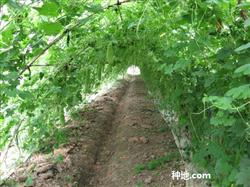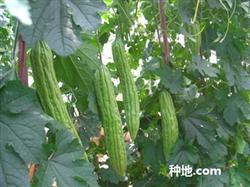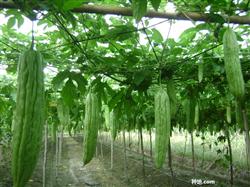How to cultivate out-of-season balsam pear?

How to cultivate out-of-season balsam pear? Please guide balsam pear is a short-day plant, light length requirements are not strict, like light is not resistant to shade, like temperature and heat resistance, not resistant to cold, like dampness and not resistant to waterlogging. The temperature required for growth and development is 15 ℃ 30 ℃, the suitable temperature for seed germination is 30 ℃, and the suitable temperature for flowering and fruiting is 20 ℃. 85% relative humidity of air and soil is needed, but it is not suitable for stagnant water. the stagnant water is easy to damage the root, the leaf wilt, the light will affect the fruit, and the plant will die if it is severe. The out-of-season production in winter in our city is mainly cultivated by means of plastic film mulching, plastic greenhouse and artificial pollination, which can be put on the market in March of the following year. The following points should be achieved in cultivation: first, soil selection and soil preparation choose medium sandy soil with convenient drainage and irrigation from the wind and sun, fertile and loose soil and high organic matter content. When the soil moisture is suitable after the late rice harvest, the cultivated land should be cultivated once a week before planting, 50 kg compound fertilizer should be applied per mu, and the whole bed should be arranged according to the specification of 1.4 meters. Second, the variety selection has white bark and long conical varieties with prominent verrucose surface, stout stem and low branch node, which has higher yield and better quality. Third, sowing time as an off-season planting, we must consider the temperature needed for the growth of balsam pear, especially to facilitate the flowering and fruiting of balsam pear. Therefore, whether it is direct seeding or nutrition bowl seedling raising, it is appropriate to sow seeds at the end of early December and the beginning of December. 4. The width of the greenhouse is about 7 meters, and the middle is 2.5 meters from the ground; the height on both sides is 1.6 meters, and five beds can be arranged in the greenhouse, each with a width of 1.4 meters. The north-south direction of the cover is better, with the length of each shed being 50m / 60m. The greenhouse material can be made of all-steel greenhouse frame produced by the factory or bow-shaped shed made of bamboo. 5. Before accelerating germination, the seeds should be dried for 4 hours, then soaked in 50 ℃ warm water for 10 minutes, then soaked in 1/1000 carbendazim solution for 10 hours, washed and wrapped with a wet cloth to accelerate germination. The temperature was controlled at 30 ℃ in the first two days and 25 ℃ in the third day. When the bud grew out of 2 mm, it could be sowed. In the process of accelerating germination, those who germinate first should sow seeds first. 6. Reasonable planting spacing of 0.5m, 0.6 m, row spacing of 0.5 m, 2 rows per row, planting depth of 2 cm. Plant about 1250 plants per mu. The direct seeding seeds can be planted when they are white, and the seedlings raised in a nutrition bowl will be transplanted for about 25 days at the age of 20 Mel. When planting, it is necessary to cover the white plastic film with a width of 0.9 meters to inhibit the growth of weeds, increase the soil temperature and keep the soil moist. 7. Field management 1. Seedling stage: high temperature and humidity must be maintained before emergence, and the appropriate temperature should be 25 ℃ and 30 ℃. The membrane should be broken when the cotyledons are exposed to the ground, and the temperature should be controlled at 18 ℃ to make the seedlings sturdy. Seedlings raised in nutrition bowls should be refined one week before planting. two。 Fertilizer and water management: according to farmers' experience in fertilizing for many years, the average yield per mu is 2500 kg balsam pear, the amount of pure nitrogen applied per mu is 18 kg, and the ratio of nitrogen, phosphorus and potassium is 1.0, 1.3 and 2.1. Base fertilizer was applied in the whole bed, accounting for 60%, topdressing accounted for 40%, and was applied in two to three times after melon fruiting. As balsam pear is easy to lose roots with stagnant water, the heavy plants will die, so the field should always be dry and wet. 3. Temperature and humidity regulation: throughout the growing period, the greenhouse should be covered with white plastic film. When the temperature in the greenhouse reaches 27 ℃, the scaffolding film should be rolled up for ventilation. When the temperature in the shed reaches 33: 00, the ventilation rate should be increased. If the air is humid in cloudy and rainy days, it should be properly ventilated. 4. Vine picking and artificial pollination: when the main vine grows the fifth true leaf, it can set up a frame for traction, and according to the strong branching ability of the lateral vine, it is removed, leaving only two lateral vines per plant. Because balsam pear is dioecious, artificial pollination must be carried out. Pollination should be mastered; on the day that the male and female flowers bloom. It is observed that when the temperature reaches 15 ℃, it will blossom every morning, but it will not blossom in the afternoon. Generally, a male flower can match 4 female flowers. When balsam pear blossoms, pick the male flowers and paste the pollen of the male flowers on the stigma of the female flowers. After insemination, the female flowers, the ovary slowly expands, and the fruit can be picked in about 20 days. 5. Pest control: the disease of balsam pear planted in off-season is more serious than that in normal season, such as downy mildew, powdery mildew, blight, anthracnose, Fusarium wilt and so on. The occurrence of disease is closely related to plant growth and development and air temperature. The prevention and control of pests should be timely. Click to get more balsam pear planting techniques click to get more vegetable planting techniques
- Prev

How to plant balsam pear efficiently?
How to plant balsam pear efficiently? Please guide balsam pear, also known as cold gourd, is a cucurbitaceae vegetable plant, like high temperature, more heat-resistant, not cold-resistant, can be planted in our county all the year round. In recent years, with the continuous adjustment and optimization of crop structure and the continuous development and demand of melon and vegetable consumption market, balsam pear has become our county's northward transportation and export.
- Next

How to trim balsam pear in arch shed?
How to trim balsam pear in arch shed? Please guide when going to the countryside to see that there are too many side vines of balsam pear planted by many vegetable farmers, resulting in poor ventilation and light, slow plant growth, seriously affecting the increase of balsam pear yield. When asked why the vegetable farmer did not trim the balsam pear, the vegetable farmer reflected that the balsam pear mainly depended on lateral vines.
Related
- Where is it suitable to grow horseradish in China? it is expected to see the middle altitude horseradish in Alishan.
- How to prevent tomato virus disease reasonably? (Control methods included)
- Many people like to plant towel gourd on the balcony. What are the main points of this method and management?
- What crops can chili peppers be mixed with?
- Fertilization techniques and matters needing attention in Tomato
- What are the grafting techniques for peach seedlings in spring?
- Harm and control methods of root swelling disease of Chinese cabbage
- What are the pests of sweet potatoes? How to prevent and cure it?
- Symptoms, causes and Control methods of navel Rot in Tomato
- The cause of "Cucumber rotten bibcock" in Farmers' planting Cucumber and its Control Plan

